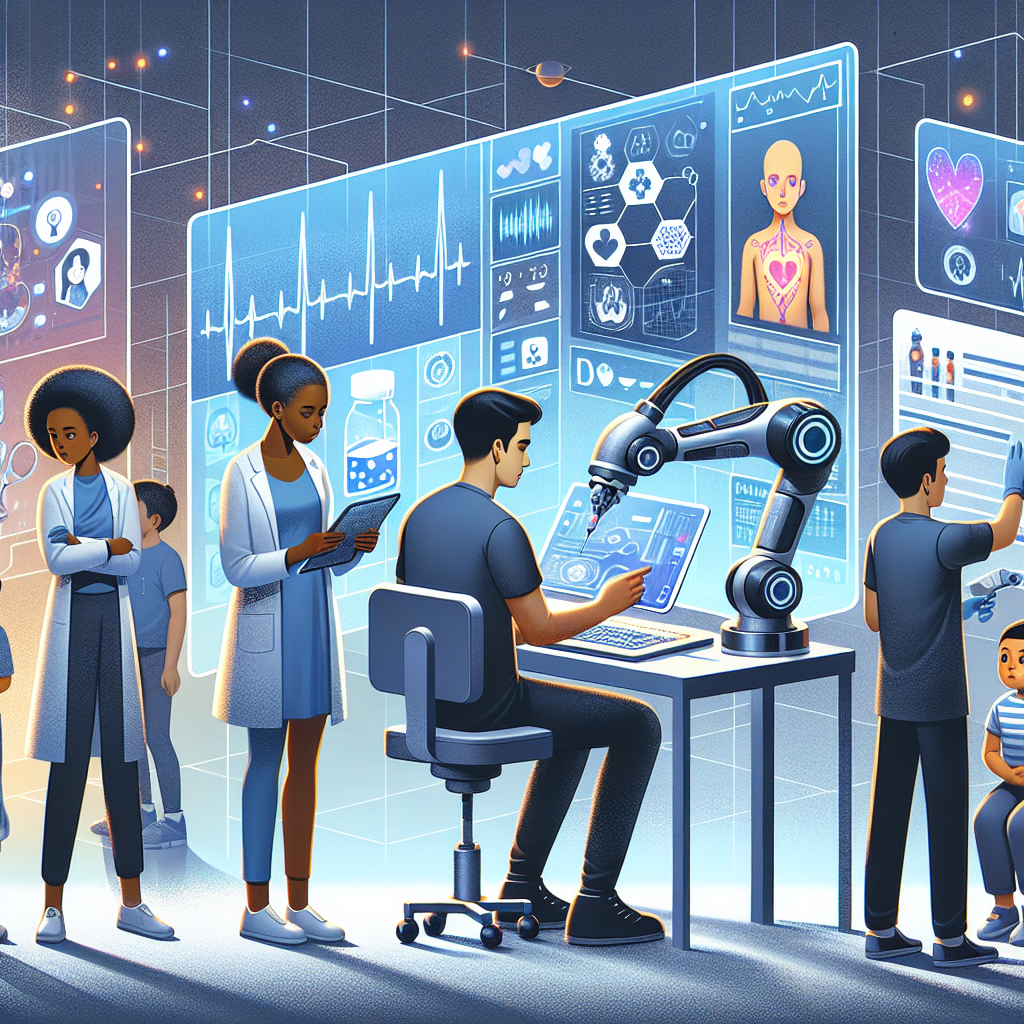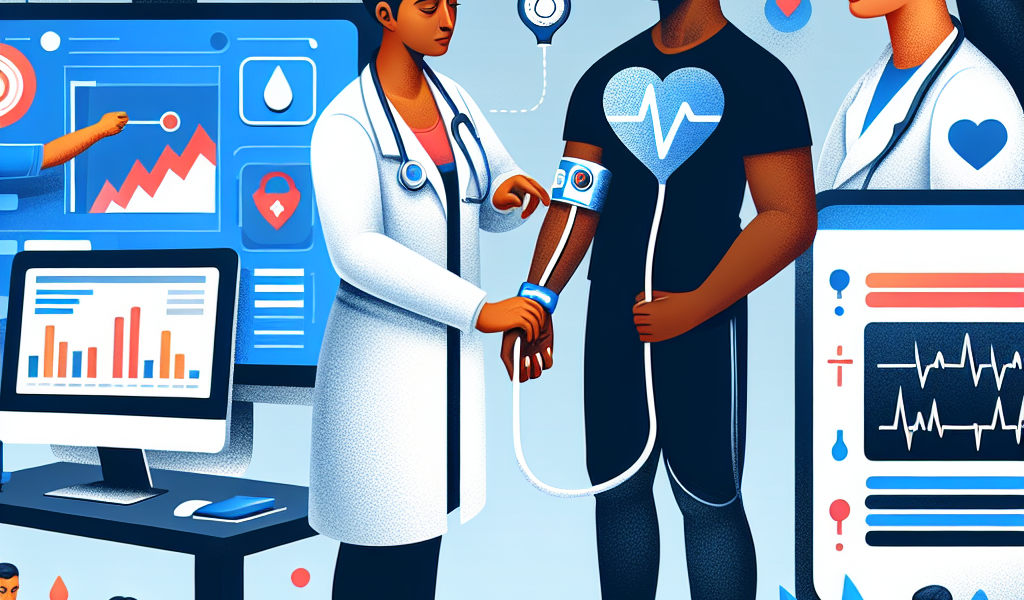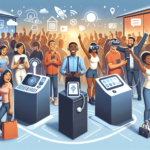-
Table of Contents
“Empowering Health: Technology’s Vital Role in Public Wellness”
Introduction

The Role of Technology in Enhancing Public Health
In recent years, the integration of technology into public health initiatives has revolutionized the way health services are delivered, monitored, and managed. From advanced data analytics and telemedicine to mobile health applications and wearable devices, technology has become a pivotal tool in addressing public health challenges. It enables real-time surveillance of disease outbreaks, facilitates remote patient monitoring, and enhances the efficiency of health care systems. Moreover, technology-driven innovations have improved access to health information, empowered individuals to take charge of their health, and fostered global collaborations in health research and policy-making. As we continue to navigate complex health landscapes, the role of technology in enhancing public health remains indispensable, offering new opportunities to improve health outcomes and promote well-being on a global scale.
The Impact of Telemedicine on Public Health Access
The advent of telemedicine has revolutionized the landscape of public health, significantly enhancing access to medical care for countless individuals. As technology continues to evolve, its integration into healthcare systems has become increasingly seamless, offering a myriad of benefits that extend far beyond the confines of traditional medical practices. Telemedicine, in particular, has emerged as a pivotal tool in bridging the gap between healthcare providers and patients, especially in underserved and remote areas.
One of the most notable impacts of telemedicine is its ability to provide timely medical consultations to individuals who might otherwise face significant barriers to accessing care. For instance, rural communities often struggle with a shortage of healthcare professionals, making it difficult for residents to receive prompt medical attention. Telemedicine addresses this issue by enabling patients to connect with specialists and primary care providers through virtual platforms, thereby eliminating the need for long and often costly travel. This not only saves time and resources but also ensures that patients receive the care they need without unnecessary delays.
Moreover, telemedicine has proven to be a game-changer for individuals with mobility issues or chronic conditions that make frequent visits to healthcare facilities challenging. By offering remote consultations, telemedicine allows these patients to manage their health more effectively from the comfort of their homes. This is particularly beneficial for elderly patients or those with disabilities, who may find it difficult to navigate physical healthcare environments. Consequently, telemedicine fosters a more inclusive healthcare system that caters to the diverse needs of the population.
In addition to improving access to care, telemedicine also enhances the quality of healthcare services. Through virtual consultations, healthcare providers can monitor patients’ progress more closely and make timely adjustments to treatment plans. This continuous oversight is crucial for managing chronic diseases such as diabetes, hypertension, and heart disease, where regular monitoring and prompt intervention can significantly improve health outcomes. Furthermore, telemedicine facilitates better communication between patients and providers, fostering a collaborative approach to healthcare that empowers patients to take an active role in managing their health.
Another significant advantage of telemedicine is its potential to alleviate the burden on healthcare facilities, particularly during times of crisis. The COVID-19 pandemic underscored the importance of telemedicine as a means of maintaining healthcare services while minimizing the risk of virus transmission. By reducing the need for in-person visits, telemedicine helped to prevent overcrowding in hospitals and clinics, thereby protecting both patients and healthcare workers. This adaptability highlights the resilience of telemedicine as a critical component of modern healthcare systems.
Despite its numerous benefits, the widespread adoption of telemedicine is not without challenges. Issues such as digital literacy, internet connectivity, and data security must be addressed to ensure equitable access to telemedicine services. Efforts to bridge the digital divide are essential to ensure that all individuals, regardless of their socioeconomic status or geographic location, can benefit from telemedicine. Additionally, robust cybersecurity measures are necessary to protect patient data and maintain the integrity of virtual healthcare platforms.
In conclusion, telemedicine has had a profound impact on public health access, offering a viable solution to many of the challenges faced by traditional healthcare systems. By leveraging technology to provide remote consultations, telemedicine enhances access to care, improves the quality of healthcare services, and alleviates the burden on healthcare facilities. As we continue to navigate the complexities of modern healthcare, the role of telemedicine will undoubtedly become increasingly integral, paving the way for a more accessible and efficient healthcare system for all.
How Wearable Technology is Revolutionizing Health Monitoring
Wearable technology is rapidly transforming the landscape of health monitoring, offering unprecedented opportunities for individuals and healthcare providers alike. These devices, ranging from smartwatches to fitness trackers, are not just trendy accessories but powerful tools that can significantly enhance public health. By continuously collecting and analyzing data, wearable technology provides real-time insights into various health metrics, enabling proactive management of one’s well-being.
One of the most significant advantages of wearable technology is its ability to monitor vital signs continuously. Devices like the Apple Watch and Fitbit can track heart rate, sleep patterns, and physical activity levels, providing users with a comprehensive overview of their health. This constant stream of data allows individuals to make informed decisions about their lifestyle, encouraging healthier habits and early detection of potential health issues. For instance, irregular heart rhythms detected by a smartwatch can prompt users to seek medical advice before a minor issue escalates into a serious condition.
Moreover, wearable technology is playing a crucial role in managing chronic diseases. For patients with conditions such as diabetes or hypertension, continuous monitoring is essential. Wearable devices equipped with sensors can track blood glucose levels or blood pressure, sending alerts when readings fall outside the normal range. This real-time feedback enables patients to take immediate corrective actions, reducing the risk of complications and hospitalizations. Additionally, the data collected can be shared with healthcare providers, facilitating more personalized and effective treatment plans.
Transitioning from individual benefits to broader public health implications, wearable technology also holds promise for epidemiological research and disease prevention. By aggregating anonymized data from millions of users, researchers can identify trends and patterns that were previously difficult to detect. For example, during the COVID-19 pandemic, wearable devices helped track symptoms and potential outbreaks, providing valuable information for public health officials. This kind of data-driven approach can enhance our understanding of disease spread and inform more targeted interventions.
Furthermore, wearable technology is fostering greater patient engagement and empowerment. With access to their health data, individuals are more likely to take an active role in managing their health. This shift towards patient-centered care is crucial in addressing the growing burden on healthcare systems. By preventing diseases and managing conditions more effectively at home, wearable technology can reduce the strain on medical facilities and resources.
However, the widespread adoption of wearable technology is not without challenges. Privacy and data security are significant concerns, as these devices collect sensitive health information. Ensuring that this data is protected from breaches and misuse is paramount. Companies must implement robust security measures and be transparent about how data is used and shared. Additionally, there is a need for standardization and regulation to ensure the accuracy and reliability of wearable devices. Inaccurate readings can lead to misdiagnoses and inappropriate treatments, undermining the potential benefits of these technologies.
Despite these challenges, the future of wearable technology in health monitoring looks promising. Advances in artificial intelligence and machine learning are expected to enhance the capabilities of these devices, providing even more precise and actionable insights. As technology continues to evolve, wearable devices will likely become an integral part of our healthcare ecosystem, driving a shift towards more proactive and personalized care.
In conclusion, wearable technology is revolutionizing health monitoring by providing continuous, real-time data that empowers individuals and enhances public health. While challenges remain, the potential benefits of these devices are immense, offering a glimpse into a future where technology and healthcare are seamlessly integrated to improve our overall well-being.
The Role of Big Data in Predicting and Preventing Disease Outbreaks
In an era where technology permeates every aspect of our lives, its role in enhancing public health has become increasingly significant. One of the most transformative applications of technology in this field is the use of big data to predict and prevent disease outbreaks. By harnessing vast amounts of information from various sources, public health officials can now identify patterns and trends that were previously undetectable, allowing for more proactive and effective responses to potential health crises.
To begin with, big data encompasses a wide range of information, including electronic health records, social media activity, travel patterns, and even climate data. When these diverse data sets are analyzed collectively, they can reveal correlations and insights that would be impossible to discern from isolated data points. For instance, during the early stages of the COVID-19 pandemic, researchers utilized big data to track the virus’s spread by analyzing travel data and social media posts. This enabled them to identify hotspots and predict where the virus might spread next, allowing for timely interventions and resource allocation.
Moreover, the predictive power of big data extends beyond immediate outbreak detection. By continuously monitoring health-related data, public health officials can identify early warning signs of potential outbreaks before they escalate. For example, an unusual spike in flu-related Google searches in a particular region might indicate the onset of an influenza outbreak. By acting on these early signals, health authorities can implement preventive measures such as vaccination campaigns or public awareness initiatives, thereby mitigating the impact of the outbreak.
In addition to predicting outbreaks, big data also plays a crucial role in understanding the factors that contribute to the spread of diseases. By analyzing data on social determinants of health, such as income levels, housing conditions, and access to healthcare, researchers can identify vulnerable populations that are at higher risk of infection. This information is invaluable for designing targeted interventions that address the root causes of health disparities and improve overall public health outcomes.
Furthermore, the integration of big data with advanced technologies like artificial intelligence (AI) and machine learning has revolutionized disease modeling and simulation. These technologies can process and analyze vast amounts of data at unprecedented speeds, generating highly accurate models that predict the trajectory of disease outbreaks. For instance, AI algorithms have been used to model the spread of diseases like Zika and Ebola, providing critical insights into how these viruses propagate and informing strategies to contain them.
However, the use of big data in public health is not without its challenges. Ensuring the privacy and security of sensitive health information is paramount, as breaches can have serious ethical and legal implications. Additionally, the sheer volume and complexity of data require sophisticated infrastructure and expertise to manage and analyze effectively. Despite these challenges, the potential benefits of big data for public health are immense, and ongoing advancements in technology continue to enhance our ability to harness this valuable resource.
In conclusion, the role of big data in predicting and preventing disease outbreaks represents a paradigm shift in public health. By leveraging the power of technology to analyze vast and diverse data sets, public health officials can gain unprecedented insights into the dynamics of disease spread, enabling more proactive and targeted interventions. As we continue to refine our data collection and analysis capabilities, the potential to improve public health outcomes and prevent future outbreaks becomes increasingly attainable.
Conclusion
Technology plays a crucial role in enhancing public health by improving disease surveillance, facilitating remote patient monitoring, enabling telemedicine, and supporting data-driven decision-making. It enhances the efficiency and effectiveness of healthcare delivery, promotes health education, and fosters global collaboration in addressing health crises. By leveraging technological advancements, public health systems can better prevent, detect, and respond to health threats, ultimately leading to improved health outcomes and reduced healthcare disparities.





